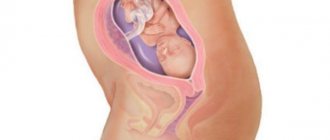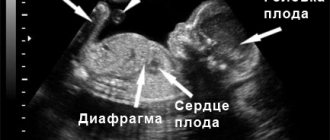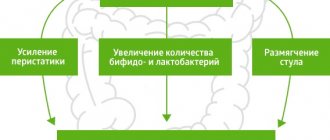Prenatal care
Regular prenatal care increases your chances of having a healthy baby
Pregnancy management is a specialized form of medical care a woman receives throughout her pregnancy. The goal of good prenatal care is to identify potential problems and complications at an early stage, and to prevent these complications, if possible (through specialized medical care, recommendations for a healthy lifestyle, adequate nutrition, exercise, and the correct prescription of vitamins).
If abnormalities are detected, pregnancy management tactics depend on their severity and the degree of risk for the mother and fetus. If a woman has health problems or a high risk of complications during pregnancy and childbirth, the doctor examines the woman more often and the management of the pregnancy is different.
Regular prenatal care for a normal pregnancy
In a physiologically progressing pregnancy, a woman is recommended an individual pregnancy management schedule, which is scheduled for all three trimesters. It indicates the frequency of visits to the doctor, the procedure for taking the necessary tests and examinations, and the frequency of consultations with specialists.
Before each visit to the gynecologist, a woman takes a urine test, which allows her to monitor her kidney function. During each appointment, the specialist weighs the woman, measures blood pressure, pulse, from 14-15 weeks determines the tone of the uterus and measures the abdominal circumference; from the second trimester, the doctor begins to listen and monitor the fetal heartbeat. Visits to the doctor will become more frequent as your due date approaches.
The general visiting schedule is as follows:
- Monthly examination by a doctor during the first two trimesters (including up to the 28th week).
- From the 28th to the 36th week of pregnancy, a woman visits an antenatal clinic once every two weeks.
- From the 36th week, the woman is examined by a gynecologist every week.
Carrying out pregnancy with a compulsory health insurance program gives the expectant mother the right to receive specialized medical care throughout pregnancy and childbirth free of charge.
There is a voluntary health insurance program where pregnancy and childbirth are paid for. In this case, pregnancy management is carried out in a private clinic or center that has licenses. Pregnancy management during voluntary health insurance costs an average of 50,000 rubles.
First visit to the gynecologist during pregnancy
First visit to the gynecologist
The first visit to the doctor at the antenatal clinic will be longer than subsequent ones. Pregnancy is confirmed during a gynecological examination and during ultrasound diagnostics. A gynecological examination will help the doctor assess the condition of the mucous membrane of the vagina and cervix, determine the position and size of the uterus and more accurately calculate the duration of pregnancy. During an initial gynecological examination, your doctor will take a smear from your cervix to check for sexually transmitted infections (STIs). In addition to this, the woman’s height and weight are recorded, blood pressure is monitored, the condition and development of the mammary glands is assessed, and the size of the pelvis is determined. Urinalysis allows you to determine sugar and protein in the urine, infectious and inflammatory processes in the kidneys and hormonal abnormalities. A blood test is necessary to identify inflammatory processes in the body, diagnose anemia, determine blood group and Rh factor, check blood clotting ability, determine the presence of antibodies to syphilis, hepatitis B and C, and conduct HIV screening.
Blood test during pregnancy
With an ultrasound examination, the doctor diagnoses the pregnancy itself, assesses possible risks for the mother (for example, an incipient miscarriage, an ectopic pregnancy or a multiple pregnancy condition) and the fetus: checks for the presence of malformations (for example, clubfoot, bifurcation of the spine, cleft palate), the doctor can diagnose intrauterine retardation development, pays attention to the development of parts of the fetal body, checks the condition of amniotic fluid and the umbilical cord. Ultrasound examinations are performed three times throughout pregnancy: at 11-12 weeks, 20-24 weeks and 30-32 weeks. The doctor may recommend additional ultrasound examination if abnormalities are detected during pregnancy.
Expert opinion
One of the optional but desirable tests is prenatal genetic screening. This is a non-invasive screening test that helps determine how high the risk of genetic abnormalities and defects in the fetus is (Down syndrome, trisomy 18, Patau syndrome, neural tube defect).
Obstetrician-gynecologist of the highest category Oksana Anatolyevna Gartleb
This test is usually carried out at 12 weeks of pregnancy. Positive screening tests require further investigation. If the risk of genetic defects is higher, doctors prescribe chorionic villus sampling, and if the risk is relatively low, they perform amniocentesis. Both tests are safe. The chorionic villus sampling test is more informative as it is performed slightly earlier than amniocentesis.
Management of complicated pregnancy
Obstetric examination of the pregnant woman and fetus
An obstetric examination includes tests such as:
- palpation of the pregnant woman’s abdomen to determine the position of the fetus;
- measuring the height of the uterine fundus and abdominal circumference using a centimeter tape to determine the expected weight of the unborn child;
- listening to the fetal heart rhythm using a stethoscope (normally 120–160 beats per minute);
- establishing the length of the cervix on the factor of its closure;
- control of the final position of the fetus and clarification of the size of the mother’s pelvis (during the last consultation before childbirth).
Management of complicated pregnancy
Pregnancy does not always go smoothly and can be complicated by many pathological conditions. Managing a difficult pregnancy requires special attention. A good doctor will be able to diagnose these changes in a timely manner and significantly reduce the risk of complications.
Serious complications of pregnancy include miscarriage, premature birth, rupture of membranes, and stillbirth. Complications can occur at any stage of pregnancy, during labor or after childbirth.
Obstetrician-gynecologist Dorina Muntyan about pregnancy management. Source – sexrfru
About 2-5% of pregnant women develop gestational diabetes. This is a form of diabetes in which the body does not produce enough insulin and blood glucose levels rise significantly, leading to serious health problems. Screening for this disease is usually done in the second trimester between 24 and 28 weeks.
If gestational diabetes is diagnosed and treated promptly, the risk of complications is low.
Women with gestational diabetes can have healthy children, but the diabetes itself should disappear after childbirth.
High blood pressure during pregnancy
High blood pressure is common during pregnancy. Hypertensive crises are extremely dangerous for women and children and can lead to such serious complications as gestosis, placental abruption, spontaneous abortion and intrauterine growth retardation.
Preeclampsia is a serious condition that is estimated to affect 5% of pregnant women. High blood pressure and impaired kidney function are common indicators of the risk of preeclampsia. Given the serious consequences of this complication, screening begins from the very beginning of pregnancy and pregnancy management is carried out in a hospital setting.
Birth statistics
Asymptomatic bacteriuria complicates 2% to 7% of pregnancies.
All pregnant women should be screened and treated between 11 and 16 weeks of pregnancy to reduce the risk of recurrent urinary tract infection, pyelonephritis, and preterm birth.
Expert opinion
Often during pregnancy, specific and nonspecific infectious and inflammatory diseases are diagnosed. These diseases can be transmitted from mother to child transplacentally or during childbirth. Complicated by stillbirth, low birth weight, premature birth. Symptoms and course depend on the causative agent of the infection.
Obstetrician-gynecologist of the highest category Oksana Anatolyevna Gartleb
The infection is often asymptomatic, so screening for STIs is important. One of the products recommended for complex therapy for sexually transmitted infections is the intimate gel “Gynocomfort”. The gel has undergone a number of clinical trials, during which their absolute safety during pregnancy was proven. Gel “Gynocomfort” will help normalize the vaginal microflora and eliminate unpleasant sensations (itching, vaginal discharge).
Pregnancy calendar in pictures - third trimester
If premature birth occurs this week, the law obliges the baby to be registered as an individual. This speaks about the development of the child. The brain is almost completely formed, but still continues to grow. To satisfy your baby's sense of harmony, you can turn on melodious, pleasant music. At this time, the mother begins to undergo changes that prepare her for the meeting of the child and the future lactation period.
The third trimester has begun, and the baby is already actively preparing for life outside the womb. The baby learns to regulate its temperature and actively accumulates fat. Continue to communicate with him and tell him about what awaits him in the future.
The thirtieth week may bring you lower back pain. This happens due to the increasing load due to the weight of the child. Learn to maintain correct posture and get out of bed correctly. This week the baby is showing more and more attention to the environment. He recognizes the intensity of light in a room well and can distinguish large objects that you show him.
The child already weighs about 1.5 kilograms, he wants to free up more space for himself, so he can turn upside down, push his legs up and press. The feeling is unpleasant for the mother, however, it must be experienced. Very soon the time of birth will come. At this time, almost all women feel increased back pain, and dilation of the veins in the legs may occur.
The baby has already grown to a considerable size. He understands well everything that is going on around him. Easily recognizes mom's voice. Sing him a lullaby, delight the baby with your voice.
This week the child learns to breathe on his own with the help of a special substance called surfactant. The baby turns upside down, he is preparing for childbirth. The doctor will tell you in more detail about the location of the baby relative to the birth canal when he prepares you for childbirth.
This week’s pregnancy development calendar indicates that your baby is gaining the ability to distinguish the taste qualities of the food you most often eat. The mother is experiencing contractions more and more often, which begin in the upper part of the uterus, then spread out and subside.
The baby has grown nails that reach the tips of his fingers. At birth, sometimes a baby may scratch himself with his nails. In the womb he is already cramped and uncomfortable. The child's weight exceeds two kilograms.
You can notice the child's chubby cheeks, which were formed due to subcutaneous fat and the baby's training in sucking his thumb. The child prepares for life and the feeding period. He is born with already developed skills.
From this week, the first signs of labor appear. Sometimes signs appear later. It depends on whether this is your first pregnancy or not. The baby goes deeper into the pelvic area, your condition becomes easier. The child is ready to come out, but there is no need to rush him. From this week the pregnancy is considered full-term. The baby can now breathe on his own.
Meconium accumulates in the child's intestines. This substance is dark green in color, which consists of disintegrated blood cells, dead cells, skin and hair particles that entered the stomach with amniotic fluid. Meconium is a baby's first feces.
Childbirth is about to begin, the uterus is dilating. Along with this, pressure occurs on the bladder, it is the strongest in all previous weeks of pregnancy. You may start to get nervous, but it is better not to allow this unpleasant emotion inside yourself.
Stay calm at 40 weeks. Childbirth is coming soon, your loved ones and relatives should fully know all the information about your birth preferences. How will this happen, where do you want to give birth? When contractions occur, remember to relax and breathe properly.
At 41 weeks, the baby may still be in the uterus, however, even he understands that he has stayed there too long.
Approximately 10% of pregnant women reach 42 weeks. There's nothing wrong with that. Perhaps the original timing was simply calculated incorrectly. During this week of pregnancy, the doctor conducts a consultation about methods of inducing labor. At 43 weeks the pregnancy is called post-term.
General symptoms of a complicated pregnancy
- Bleeding or leakage of amniotic fluid.
- Severe swelling of the face, hands, or fingers.
- Severe and prolonged headaches, dizziness.
- Discomfort, pain, or cramping sensation in the lower abdomen.
- Fever, chills.
- Constant vomiting or nausea.
- Discomfort, pain or burning when urinating.
- Visual impairment.
Management of pregnancy pathology
Management of pregnancy and treatment will depend on the type of complication and pathological processes that occur during pregnancy.
Includes: careful monitoring, bed rest, hospitalization in an inpatient department, changes and restrictions in diet, drug therapy.
Medical examination when managing a healthy pregnancy
Management of pregnancy and childbirth
From the moment of registration, an exchange card is issued for each woman, which indicates the woman’s personal data, the results of all tests and examinations performed, data on the course of the pregnancy itself, how the birth took place, information about the newborn child. At the beginning of the expected period of childbirth, the exchange card is transferred to the maternity hospital. From the third trimester, each woman is given a birth certificate, which gives her the right to choose her own maternity hospital.
In a healthy pregnancy, delivery occurs at 37-41 weeks.
If a woman has the first signs of labor, she goes to the maternity hospital on her own or by calling an ambulance.
Management of pregnancy in the 3rd trimester and childbirth depends on the pregnancy itself.
Childbirth management is specialized care for a woman and child at all stages of labor.
Sources:
- Guide to outpatient care in obstetrics and gynecology. Radzinsky V.E., Prilepskaya V.N., Kulakov V.I. Publisher: Geotar-Media. – 2007.
- Diabetes mellitus in pregnant women. Makarov O.V. – 2010.
- Women's consultation. Management. Editor: Radzinsky V.E. Publisher: Geotar-Media. – 2009.
- Preeclampsia and chronic arterial hypertension. Clinical aspects. Makarov O.V., Tkacheva O.N., Volkova E.V. Publisher: Geotar-Media.
Chinese pregnancy calendar
The Chinese pregnancy calendar is a chart that allows you to determine the sex of the child depending on the age of the mother and the expected date of birth of the baby. Such a calendar was used back in ancient China so that imperial families could give birth to a boy who would continue the family name. Now in China, any testing for the sex of a child is considered illegal.
There are some tests that can help determine the sex of the baby. Most people say that it is not effective, often makes mistakes, and is also expensive.
Understanding the Chinese pregnancy calendar is easy. Scroll down the age column, then select the month in which the pregnancy is expected to end. The intersection will tell you whether you are having a boy or a girl. Remember that this is just an attempt to guess and nothing more. More plausible information will be when you wait until the due date and do an ultrasound.
Interestingly, it is the father who really influences the sex of the child. A fertilized egg always contains an X chromosome. The second sex chromosome comes from the father. It can be an x chromosome or a y chromosome. Accordingly, fertilization with the x chromosome will lead to the appearance of a girl in your family, and fertilization with the y chromosome will give you a boy.
Popular questions
I'm 8-9 weeks pregnant.
I urgently need help, I am constipated, please tell me what laxative I can take? During pregnancy, it is very important to monitor the regularity of bowel movements, as constipation can provoke a threat of miscarriage. For correction, the following are used: mineral water with magnesium, preparations with lactulose, microlax, etc. In each case, the combination of drugs is selected individually. This issue is being resolved with a gastroenterologist.
Pregnancy 35 weeks. I have had periodic contractions for 6 days now, leading to active cleansing of the body. Today I weighed myself - minus 3 kg. See the doctor on Monday. Should I go to the hospital or is this normal?
You should contact your maternity hospital to assess the risk of premature birth.
Hello, I’m pregnant, 6 weeks pregnant, I had an appointment with the gynecologist 2 days ago. I was informed that there was a threat of miscarriage and was prescribed the drug Utrozhestan 200 mg intravaginally once a day, I used it that same day at night before bed, and during the day I saw another gynecologist to make sure how serious the threat was, but they reported that there was no threat, and all this pain is due to the back. I’ve been taking Utrozhestan for 2 days now, they said that I can’t stop it abruptly, but this drug has kept me awake for 2 days, constant dizziness, nausea and faintness, as well as burning and discomfort. I would like to know how to stop taking the drug as quickly as possible?
Hello! To clarify the diagnosis - there is a threat of miscarriage, an ultrasound is performed, where it is determined whether there is uterine tone, and the shape of the fertilized egg is assessed. The complaints you described may relate not only to side effects of the drug, but also accompany pregnancy up to 12 weeks. It is necessary to discuss with the treating doctor the replacement of the drug with a tablet form, and also perform an examination - a smear for flora, a general urine test, a general blood test, a biochemical analysis.
Hello, I'm pregnant, 13 weeks. At the moment my left side and lower abdomen are very painful, what should I do?
Hello!
The appearance of pain of any nature during pregnancy requires immediate contact with an obstetrician-gynecologist to determine the cause and eliminate the pain. Pain may mean a threat of miscarriage, or may be associated with other diseases, such as intestines, kidneys, spine, etc. In any case, the pain must be eliminated. For an accurate diagnosis, contact a specialist
Adjusting collage sizes
After the template is selected, the editor will ask you to determine the format of the future product. Specify the page parameters, its width and height, resolution and orientation.
You can also customize the canvas dimensions.
If you intend to print the collage in the future, save your work with a resolution of at least 300dpi
. The higher the image quality, the better the printed copy. If you want to transfer an image to a T-shirt or mug, then you should know what parameters you need to select for the sheet settings. For example, the maximum application size for standard mugs is 200 (width) by 90 (height) mm.











